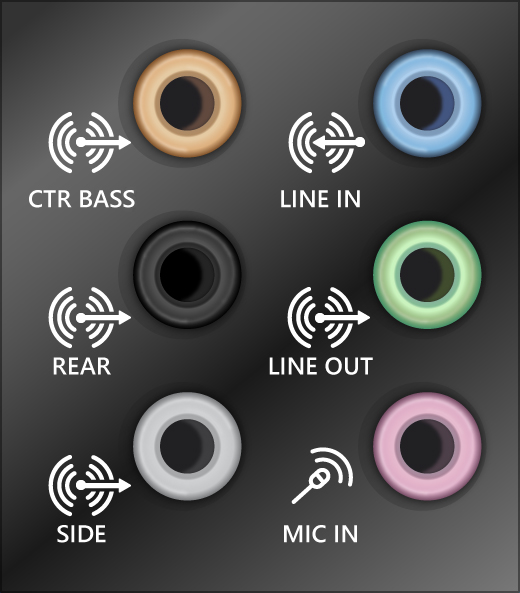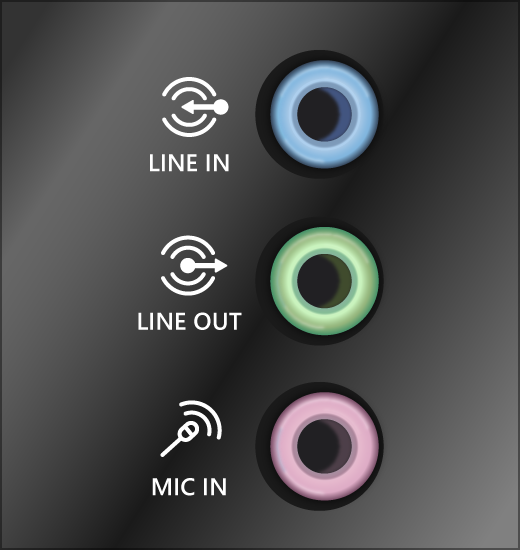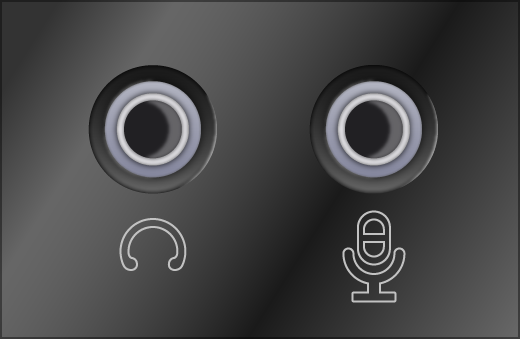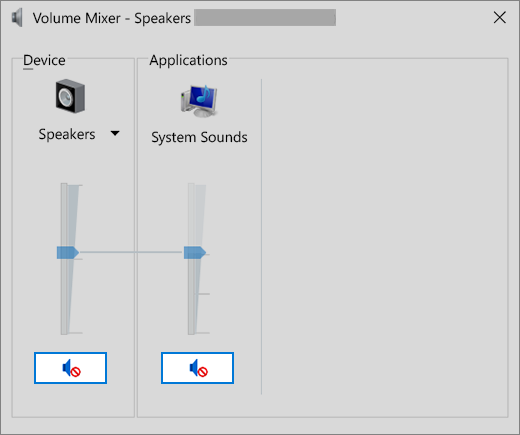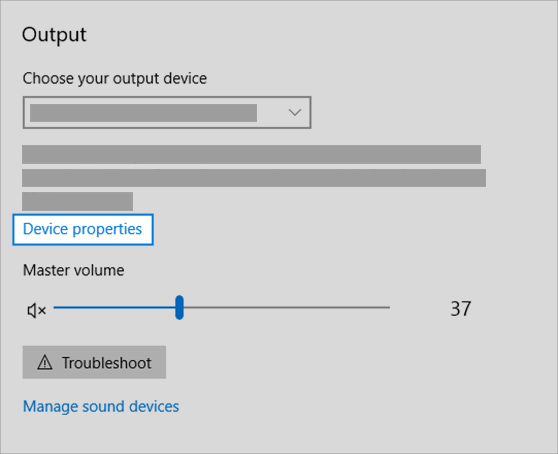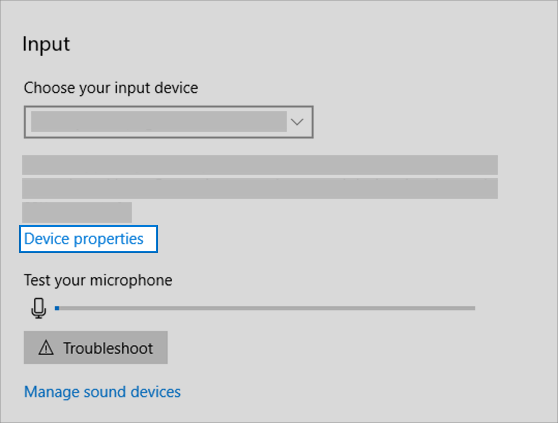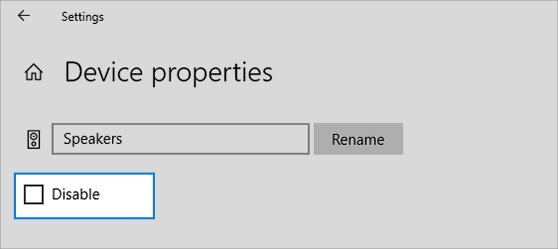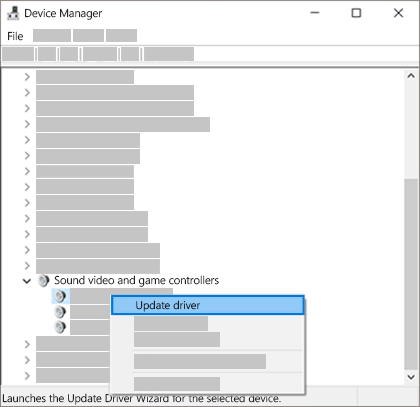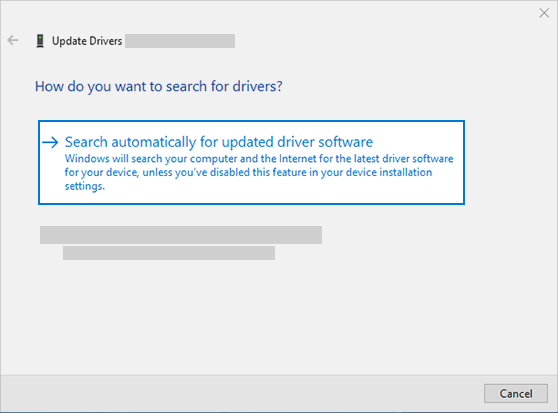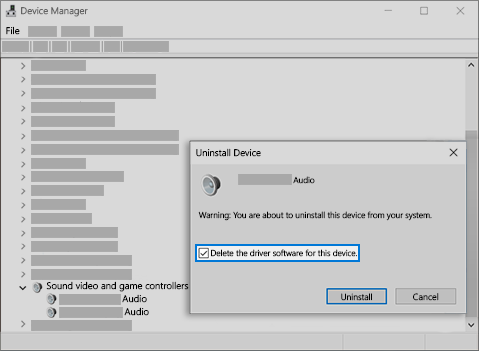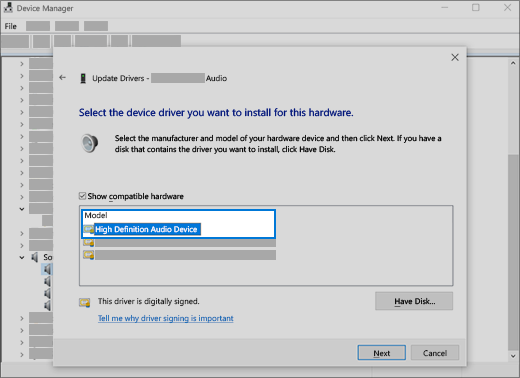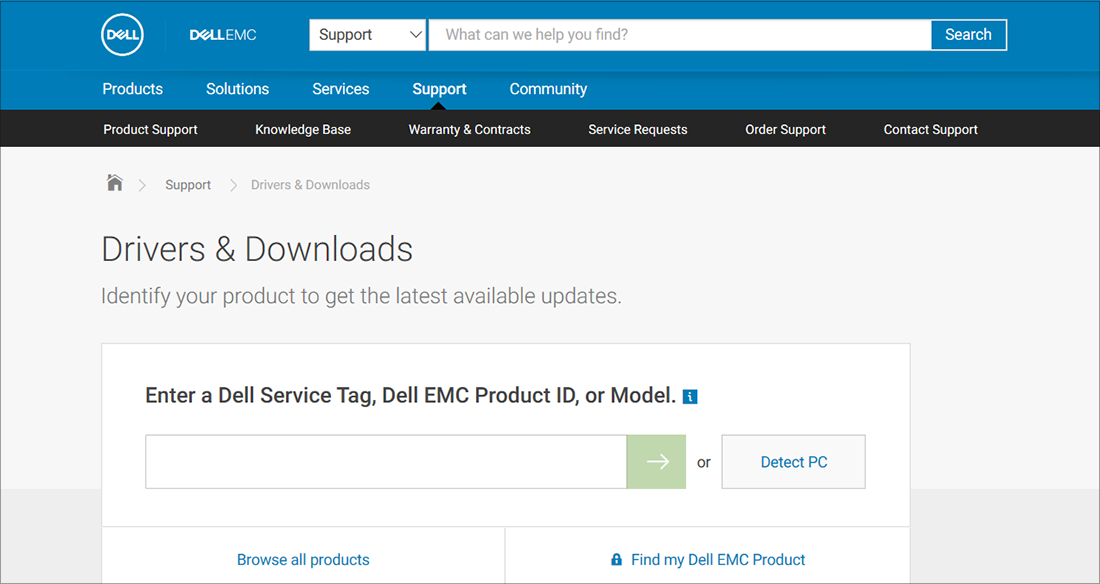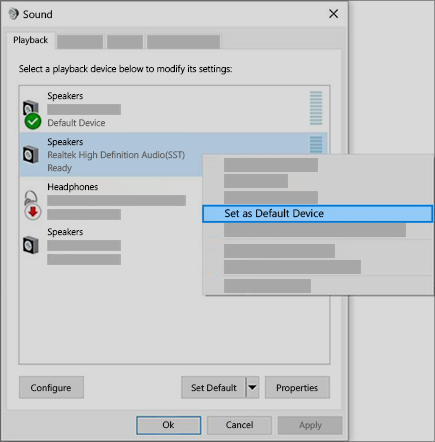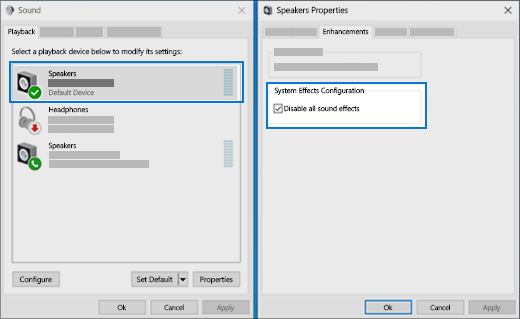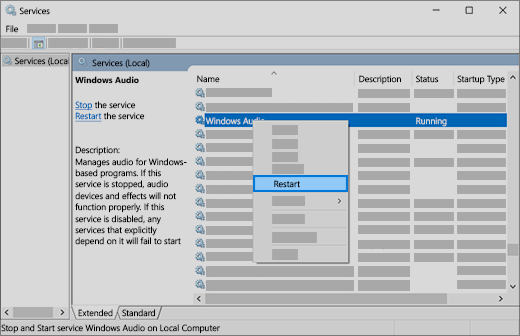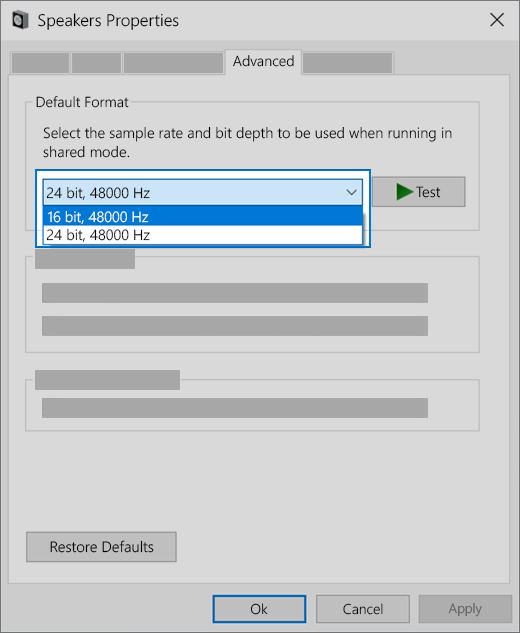Fix sound problems in Windows 10
If you’re having audio problems, the following suggestions might help. The tips are listed in order, so start with the first one, see if that helps, and then continue to the next one if it doesn’t.
If multiple audio output devices are available, check that you have the appropriate one selected. Here’s how:
Select the Speakers icon on the taskbar.
Next, select the arrow to open a list of audio devices connected to your computer.
Check that your audio is playing to the audio device you prefer, such as a speaker or headphones.
If this doesn’t help, continue to the next tip.
The audio troubleshooter might be able to fix audio problems automatically.
To run the troubleshooter
In the search box on the taskbar, type audio troubleshooter, select Fix and find problems with playing sound from the results, then select Next.
Select the device you want to troubleshoot and then continue through the troubleshooter.
You can also launch the troubleshooter from audio Settings. Select Start > Settings > System > Sound > Troubleshoot.
If running the troubleshooter doesn’t help, continue to the next tip.
To check for updates
Select Start > Settings > Update & Security > Windows Update > Check for updates.
Do one of the following:
If the status says «You’re up to date, go to the next tip.
If the status says «Updates are available,» select Install now.
Select the updates you want to install, then select Install.
Restart your PC and see if your sound is working properly.
If that didn’t solve your problem, continue to the next tip.
Try these steps
Check your speaker and headphone connections for loose cords or cables. Make sure all cords and cables are plugged in.
If you have multiple 5mm jacks to plug into, especially on a surround sound system, make sure all cords and cables are plugged into the correct jack.
If it’s not clear which jack goes with which cord, consult your hardware manufacturer, or try the most obvious outputs one at a time and see if they work.
Note: Some systems use a green jack for output and pink for mic input and others will be labeled «headphone» or «microphone.»
Make sure the power is turned on and check the volume level.
Make sure the mute setting is not turned on, and try turning up all the volume controls.
Remember some speakers and apps have their own volume controls. Be sure to check them all.
Try connecting your speaker and headphones to a different USB port.
It’s possible that your speakers won’t work when your headphones are plugged in. Unplug your headphones and see if that helps.
If your cables and volume are OK, see the next sections for additional troubleshooting.
Check to make sure your audio devices aren’t muted and haven’t been disabled.
Right-click the Speakers icon on the taskbar, and then select Open Volume mixer.
You’ll see a set of volume controls for your devices. Make sure none of them are muted. If any of them are muted, you’ll see a red circle with a line through it next to the volume control. In that case, select the volume control to unmute.
Check your device properties to make sure that your devices have not been disabled by mistake. Select Start > Settings > System > Sound .
Select your audio device, and then select Device properties. Be sure to select Device properties for both the output and input devices.
Make sure the Disable check box is cleared for the output and input devices.
If that didn’t solve your problem, continue to the next tip.
Hardware problems can be caused by outdated or malfunctioning drivers. Make sure your audio driver is up to date and update it if needed. If that doesn’t work, try uninstalling the audio driver (it will reinstall automatically). If that doesn’t work, try using the generic audio driver that comes with Windows. If you’re having audio issues after installing updates, try rolling back your audio driver.
To update your audio driver automatically
In the search box on the taskbar, type device manager, then select it from the results.
Select the arrow next to Sound, video and game controllers to expand it.
Right-click the listing for your sound card or audio device, such as headphones or speakers, select Update driver, then select Search automatically for updated driver software. Follow the instructions to complete the update.
If Windows doesn’t find a new driver, look for one on the device manufacturer’s website and follow those instructions. If that doesn’t work, try uninstalling your audio driver.
To uninstall your audio driver
In the search box on the taskbar, type device manager, then select it from the results.
Select the arrow next to Sound, video and game controllers to expand it.
Right-click the listing for your sound card or audio device, select Uninstall device, select the Delete the driver software for this device check box, and then select Uninstall.
Restart your PC.
Note: Be sure to save documents and any other current work before you restart.
This restart will automatically prompt your PC to reinstall your audio driver.
To restart, select Start > Power > Restart .
If those options didn’t work, try using the generic audio driver that comes with Windows.
To use the generic audio driver that comes with Windows
In the search box on the taskbar, type device manager, then select it from the results.
Select the arrow next to Sound, video and game controllers to expand it.
Right-click the listing for your sound card or audio device, then select Update driver > Browse my computer for driver software > Let me pick from a list of device drivers on my computer.
Select the audio device whose driver you want to update, select Next, and then follow the instructions to install it.
If these steps didn’t solve your audio issue, visit your device manufacturer’s website and install the most recent audio/sound drivers for your device. Following is an example of a driver download page for a sound device manufacturer.
If you have audio issues after installing updates
If your audio was working before you ran Windows Update and now isn’t working, try rolling back your audio driver.
To roll back your audio driver
In the search box on the taskbar, type device manager, then select it from the results.
Select the arrow next to Sound, video and game controllers to expand it.
Right-click the listing for your sound card or audio device, then select Properties.
Select the Driver tab, then select Roll Back Driver.
Read and follow the instructions and then select Yes if you want to roll back your audio driver.
If rolling back your audio driver didn’t work or wasn’t an option, you can try to restore your PC from a system restore point.
Restore your PC from a system restore point
When Microsoft installs updates on your system, we create a system restore point in case problems arise. Try restoring from that point and see if that fixes your sound problems. For more info, see «Restore from a system restore point» in Recovery options in Windows 10.
If you’re connecting to an audio device—such as headphones or speakers—using USB or HDMI, you might need to set that device as the default audio device. If you’re using an external monitor that doesn’t have built-in speakers, make sure that the monitor isn’t already selected as your default output device. if it is, you won’t have any audio. You can check that when you set your default output audio device. Here’s how:
In the search box on the taskbar, type control panel, then select it from the results.
Select Hardware and Sound from the Control Panel, and then select Sound.
On the Playback tab, right-click the listing for your audio device, select Set as Default Device, and then select OK.
If setting your audio device as the default device doesn’t help, continue to the next tip for additional troubleshooting.
Sometimes having audio enhancements on can result in audio issues. Disabling them may resolve your issue.
In the search box on the taskbar, type control panel, then select it from the results.
Select Hardware and Sound from the Control Panel, and then select Sound.
On the Playback tab, right-click the Default Device, and then select Properties.
On the Enhancements tab, select either the Disable all enhancements or the Disable all sound effects check box (depending on which option you see), select OK, and try to play your audio device.
If that doesn’t work, on the Playback tab, select another default device (if you have one), select either the Disable all enhancements or the Disable all sound effects check box (depending on which option you see), select OK, and try to play audio again. Do this for each default device.
If turning off audio enhancements doesn’t help, see the next sections for additional troubleshooting.
In the search box on the taskbar, type services, then select it from the results.
Select each of the following services, right-click, and then select Restart:
Windows Audio Endpoint Builder
Remote Procedure Call (RPC)
If restarting these services doesn’t resolve your issue, see the next sections for more troubleshooting.
In the search box on the taskbar, type control panel, and then select it from the results.
Select Hardware and Sound from the Control Panel, and then select Sound.
On the Playback tab, right-click (or press and hold) Default Device, and then select Properties.
On the Advanced tab, under Default Format, change the setting, select OK,and then test your audio device. If that doesn’t work, try changing the setting again.
If trying different audio formats doesn’t help, see the next sections for additional troubleshooting.
Many updates require you to restart your device.
To check and see if you have installed updates pending and need to restart
Save your work and close all open applications.
Select Start > Power . If you have installed updates pending, you’ll see options to Update and restart and Update and shut down.
Select one of those restart options to apply the updates
If restarting doesn’t help, see the next section for additional troubleshooting.
Some audio problems might be caused by an issue with the audio system’s IDT High Definition Audio CODEC. This can be fixed with a manual driver update which allows you to choose the sound driver you want to use.
Note: Not all systems will have an IDT High Definition Audio CODEC.
To check and see if you have one, and to manually update the driver
In the search box on the taskbar, type device manager, then select it from the results.
Select the arrow next to Sound, video and game controllers to expand it.
Look for IDT High Definition Audio CODEC. If it’s listed, right-click it and select Update driver, then select Browse my computer for driver software > Let me pick from a list of device drivers on my computer.
You’ll see a list of pre-installed drivers. Select High Definition Audio Device, and then select Next.
1. Select Start > Settings > Privacy , and then select Microphone from the left menu.
Under Allow access to the microphone on this device, select Change. Make sure the toggle is turned On.
If you’re having this issue with a specific app, scroll down to Choose which Microsoft Store apps can access your microphone and make sure that the toggle next to that app is turned On as well.
No Audio or Sound is missing on Windows 10 computer
Some of you may have faced this problem at some point – there is no sound in Windows 10/8/7. If you are facing such as No Audio or Sound is missing problem, this tutorial may help you resolve the issue. Before you begin, just ensure that you have plugged in all the cables properly and that you have not muted the speakers by mistake.
No Sound on Windows 10 computer
To troubleshoot this No sound issue, you will have to look at the following aspects:
- Check your Driver
- Check your sound card
- Set the correct audio device as default
- Disable enhancements
- Check if the Speakers & headphones cables are connected properly
- Change audio format
- Check if the HDMI cables are connected properly
- Run Sound and Audio Troubleshooter.
1] Check your Driver
Normally you would open Control Panel > Sound > Under Playback and Recording tabs, Select and Set Defaults. Additionally or alternatively, you may also have to try this: Click Start > Type Device Manager in Start Menu Search Bar > Hit Enter.
The Device Manager will open. Expand Sound, Video and Game Controllers. Locate your audio device. Double-click on it to open its Properties box. See whether the driver is installed and the device working properly.
In the Driver tab, click on Update Driver. Click OK. Else you may have to uninstall the Driver (but DONT delete it) and then in the Device Manager > Action > Scan for hardware changes. This will reinstall the driver.
2] Check your sound card
Ensure that your Windows PC has a sound card or sound processor, and it’s working properly. To check this, select the ‘Search’ option from the charms-bar, type – Device Manager’ and click ‘Settings’. Open Device Manager, double-click Sound, video and game controllers to expand that category. If a sound card is listed, you have one installed. Laptops and tablets do not usually have sound cards. Instead, they have integrated sound processors, which appear in the same category in Device Manager.
See if it is working properly. If Device Status shows that the device is working correctly, the problem showing up is due to sound settings, the speakers, or the cables.
3] Set the correct audio device as default
Type ‘Sound’ in search and select ‘Settings’. Choose ‘Sound’. Under the Playback tab section, you will find multiple audio devices; appearing as speaker, followed by the name of the device. You will also observe that the default device shows a green a check beside it, labeled as Default if you have multiple devices.
If the wrong audio device is listed as the default audio device, simply choose the correct device and click ‘Set Default’ button. Restart your PC!
4] Disable enhancements
In the Sound Control Panel on the Playback tab, right-click the Default Device and select Properties. On the Enhancements tab, select Disable all enhancements and see if you can play your audio device. If it helps, great, else do this for each default device, and see if any help.
5] Check if the Speakers and headphones cables are connected properly
New PCs these days are equipped with 3 or more jacks including,
- a microphone jack
- line-in jack
- line-out jack.
These jacks connect to a sound processor. So make sure your speakers are plugged into the line-out jack. If unsure which is the right jack, try plugging speakers in to each of the jacks and see it produces any sound.
If you’re using headphones, make sure speakers aren’t plugged into the line out (headphone) jack of your sound card or PC.
6] Change audio format
In the Sound Control Panel on the Playback tab, right-click the Default Device and select Properties. On the Advanced tab, under Default Format, change the setting, and then check your audio device. If it helps, great, else change the setting again and see if that helps.
7] Check if the HDMI cables are connected properly
If you are using an HDMI cable to connect your PC to a monitor with speakers that supports HDMI, chances are you might not hear the sound. In such a situation you need to set the HDMI audio device as the default. To check to see if the sound is supported by HDMI follow these steps:
Enter Sound in the search box, and click Settings. Next, choose Sound. Under the Playback tab look for an HDMI device. If you have an HDMI device, click Set Default button and hit OK. Changing the audio device might require you to restart your PC.
Your HDMI monitor should have an audio input if you don’t have an HDMI audio device. What you are required to do then is connect a separate audio cable from your PC sound card directly to the monitor. If the monitor doesn’t have speakers, you’ll need to connect the audio signal to a different device, such as external PC speakers or your home stereo system.
8] Run Sound and Audio Troubleshooter
If all fails, you may bring in and use the built-in Troubleshooting tool in Windows 10/8. The tool may automatically fix the audio recording problem.
To open the Sound and Audio Troubleshooter, bring up the Control Panel by pressing Win+X in combination and selecting Control Panel. Then, under System and Security click Find and fix problems. Or else, simply right-click on the Speaker icon in the Taskbar notification area and select Troubleshoot sound problems to open the Sound and Audio Troubleshooter.
When done, choose ‘Hardware and Sound’ and click on ‘Troubleshoot audio recording‘ link. This post on Windows Sound is not working or missing may also give you some pointers.
While this post has been written keeping Windows 10 and Windows 8 in mind, it will help if you face the No Sound problem on other Windows versions too.
Windows 7, Windows Vista or Windows XP users can download this Fix It to diagnose, troubleshoot, repair sound & audio problems.

